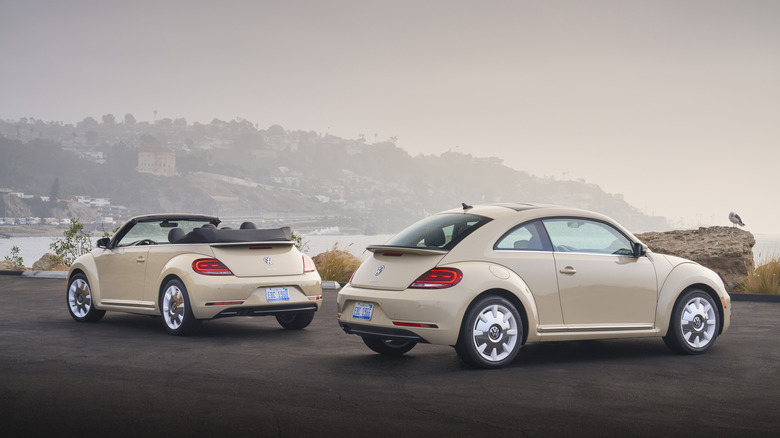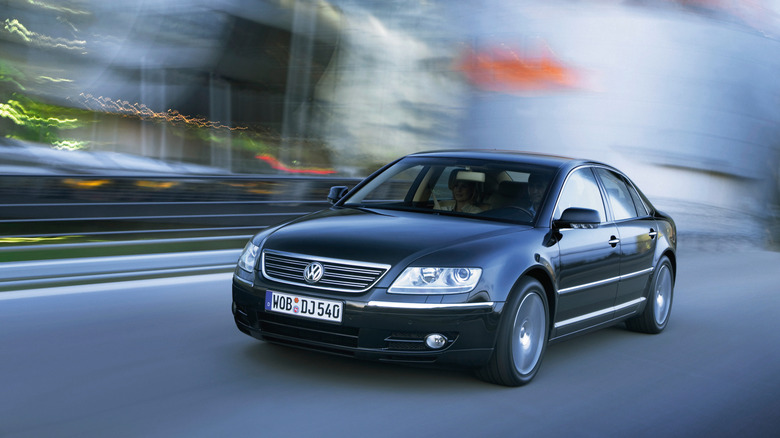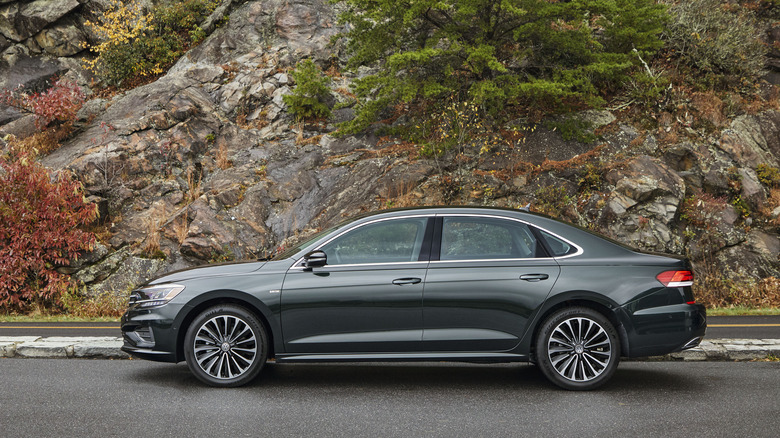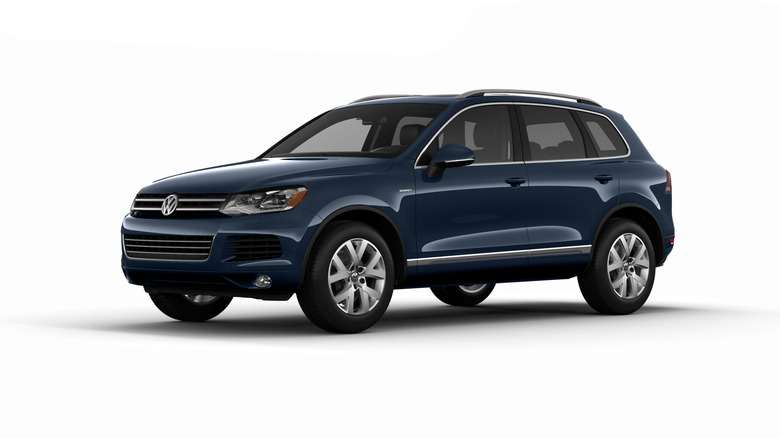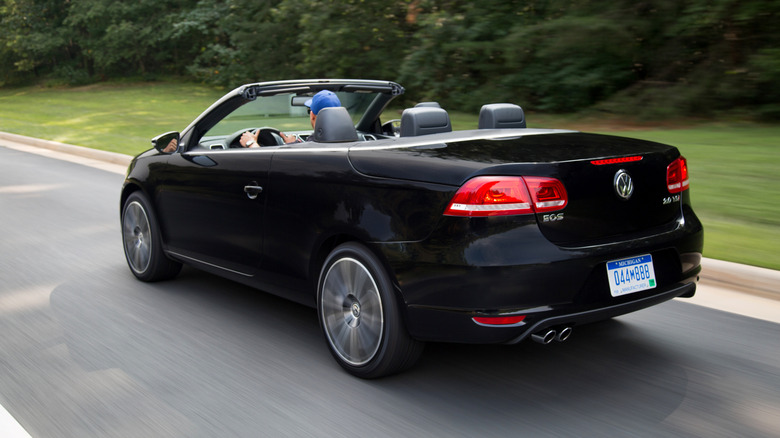5 Discontinued Volkswagen Models To Consider Putting In Your Garage
Volkswagen's appeal to used car buyers can be summed up by three attributes: the driving experience, engineering, and affordability. Let's consider the first: Volkswagen has long been known for its driver-focused cars. When American manufacturers were building huge, floaty sedans and station wagons in the mid-1970s, Volkswagen introduced agile, spirited front-wheel drive cars like the Scirocco. This classic Volkswagen model weighed only 1,700 pounds and featured a peppy overhead-cam four-cylinder engine. VW's appeal to passionate drivers would later inspire a 1990s ad campaign in which the company introduced the word Fahrvergnügen, which translates roughly into "driving enjoyment."
The pleasure of driving a Volkswagen comes in large part from the second of the three attributes: its German engineering. It might seem like another catchy advertising slogan, but Car and Driver agrees that it's a real thing. In 2018, the magazine interviewed Stefan Gies, an engineer in charge of chassis development at Volkswagen, who explained that the phrase stands for "precision in the design and what you feel in the car." From a stiff body structure to the suspension architecture to the feel of the pedals and the steering responsiveness, VWs exhibit Teutonic exactitude.
This brings us to the third attribute: Volkswagens are affordable for German cars. While the company has tried to move upmarket in recent years, VW buyers can still get into a German-designed car at a much lower price than Mercedes-Benz or BMW models. As used cars, they offer an even greater bargain. The online used car seller CarGurus.com reports that Volkswagens cost 28.7% less than the market average for used cars. Yet according to CarMax, another used car seller, Volkswagen's reliability is above average, with slightly lower-than-average repair costs. What's not to love?
2004-2006 Volkswagen Phaeton
The Phaeton was a huge whiff for Volkswagen, especially here in the U.S., where it was only sold from 2004 through 2006. With a price range of roughly $65,000 for a V8 model and $100,000 for a W-12 model, it aimed for the stratosphere of luxury where cars like the Mercedes S-Class and BMW 7-Series play. Yet, with its unmistakable resemblance to the Passat, buyers didn't bite. The failure made the Phaeton's name ironic: it derives from the mythological Phaethon, son of the sun god Helios, who ambitiously tried and failed to drive his father's chariot in the heavens before being struck down by a wrathful Zeus.
The Phaeton's failure equals the used car buyer's gain. KBB.com observes that this once-grandiose chariot can now be had for under $5,000 while also noting the Phaeton buyers gave the sedan an average rating of 4.8 out of 5, with 94% of owners recommending it. Owners describe it with words and phrases like "flawless" and "an absolute pleasure to drive," as well as "the best car I've ever owned" and "Stealth Wealth."
That last phrase is appropriate since the Phaeton rides on the same platform as the Bentley Continental GT and the Rolls-Royce Flying Spur, both of which are far, far more expensive than the Phaeton. The lower trim level is powered by a 4.2-liter, 335-horsepower V8, but you may be lucky enough to find a Phaeton equipped with the 6.0-liter, 420-horsepower W-12, one of the most powerful auto engines Volkswagen ever built. While Volkswagen may have discontinued its most luxurious car because the marketplace struck it down with the fury of Zeus, the Phaeton's failure could be a tremendous opportunity for you.
2012-2022 Volkswagen Passat
Volkswagen enlarged its bread-and-butter Passat sedan in 2012 to cater to the tastes of American buyers but discontinued it after the 2022 model year. So, what happened to the Volkswagen Passat? As with many sedans in recent years, the Passat fell victim to the shift in American driving preferences toward SUVs. After more than 30 years in the U.S. market or almost 50 years if you include the Dasher and Quantum models that preceded it, Volkswagen's middle-of-the-road sedan gave way to today's default passenger vehicle style. Volkswagen's current lineup includes only one sedan, the compact Jetta.
Perhaps because many used car buyers also prefer SUVs instead of sedans, the Passat is a decent buy on the used car market. CarGurus.com notes that the average used Passat is 58% less expensive than the average used car, with recent models selling for about $11,700. We recommend Passats from the 2012 through 2022 model years due to their useful size and equipment levels. Motor Trend's review of the 2012 model noted that it came equipped with safety features like Volkswagen's Intelligent Crash Response System, along with ABS, traction control, and more.
Engine choices in 2012 included a 2.5-liter, 170-horsepower inline five-cylinder, a 3.6-liter, 280-horsepower V6, and a 2.0-liter, 140-horsepower turbodiesel inline-four. By 2022, engine choice had narrowed to a 2.0-liter, 174-horsepower, turbocharged inline-four, with which Car and Driver achieved an 8.3-second 0-60 time and a combined city and highway fuel economy of 27 mpg. They also noted the Passat's huge back seat, which could be a boon to car shoppers with children who still ride in car seats or booster seats.
2012-2019 Volkswagen Beetle
The last generation of the incredibly long-lived Beetle ran from 2012 through 2019 before fading away. The reason Volkswagen discontinued the Beetle is much the same reason it killed off the Passat: buyers increasingly prefer SUVs. And that's a shame. Even though today's cars and SUVs are fast, economical, safe, and well-equipped, most of them are not overburdened with personality — something the Beetle has in spades. While the last generation of the Beetle didn't win raves from car critics, its retro looks stand out from a sea of anonymous, ultra-aerodynamic small cars and SUVs.
If you do decide you want the charisma and charm of a Beetle, the final generation offers numerous options for your personality and style. When the 2012 Beetle debuted, it offered an optional 200-horsepower turbocharged four-cylinder in addition to the base model five-cylinder. The 2013 model added a diesel and a convertible, along with new premium options, and the 2014 and 2015 Beetles offered retro trims and a more powerful diesel. In 2016, the Beetle got modern touches like a touchscreen, Apple CarPlay, and Android Auto. By 2018, engine choices had narrowed to a 174-horsepower turbocharged four-cylinder.
Car value website KBB.com says prices for decent 2012 models begin at just $6,900, while a turbo convertible will fetch a bit north of $9,300. Owners awarded the 2012 Beetle a reliability score of 4.5 out of 5. For newer 2019 models, KBB.com states that prices rise to $16,600 for base models and almost $23,000 for a Final Edition convertible. Your sweet spot may be in models from the mid-teens, where you can pick up a 2015 base model for about $8,500.
2010-2017 Volkswagen Touareg
Returning to the theme of stealth wealth, the Volkswagen Touareg SUV is more interesting than you may remember. It shared a platform with the first-gen Porsche Cayenne and was a premium model for VW in its day. The general verdict is that it was good, but not as good as its then-lofty price tag, which by 2017 had started at around $50,000 and could reach the $60,000 mark. Luckily for prospective buyers, used values have depreciated sharply since it was discontinued after the 2017 model year, allowing you to get a Cayenne in disguise at a bargain price.
We recommend the Touareg II second-generation model, which was larger, longer, more luxurious, and graced with a redesigned, premium-looking exterior. Keep an eye out for a special feature available in 2011 models and later, after which Volkswagen dropped its first-ever hybrid system into the Touareg, pairing an electric motor with a V6 for a combined output of 380 horsepower. This option replaced an earlier 10-cylinder diesel engine.
We mentioned depreciation, and here's where the Touareg should really catch your attention. According to KBB.com, even the newest 2017 models have dropped in price to between $14,500 and a bit over $17,200, down from $50,765 to $61,105 — a rough situation for the original owners but a bargain opportunity for you. Or opt for a 2010 model, and you can snag a base Touareg for not much more than $5,000. And when you roll up next to a Cayenne at a stoplight, you can give its driver a knowing wink.
2007-2016 Volkswagen Eos
In classical Greece, Eos was the goddess of the dawn. This makes Eos a great name for a car whose trick convertible roof folded back to reveal the glorious light of day. This clever roof could fold back into the boot like a traditional hardtop, or the glass front section could tilt or slide back like a moonroof. Introduced in 2007, the Eos never really caught on in the U.S. and was officially discontinued with a Final Edition in 2015, although production continued through November of 2015, resulting in a limited number of 2016 models.
The Eos's lack of popularity means something for buyers: used prices are pretty low, and it's not a car that you'll see many of on the road. In fact, you may get quite a few startled looks, followed by the question, "What the heck is that?" Plus, you can enjoy the wind in your hair on sunny afternoons and moonlit nights for as little as $4,444 for a 2007 model or just under $9,700 for a 2016 Eos, according to KBB.com.
While no one would mistake the Eos for a high-performance machine, some model years did offer a turbocharged option. For instance, the 2015 Eos sported an optional 2.0-liter, 200-horsepower inline four-cylinder engine. It's a bit too heavy for spirited handling, but acceleration is decent in turbo models. Despite its weight, the Eos is a small convertible with a tight interior space, so this is more of a weekend cruiser than a carpool vehicle. The Eos was restyled in 2012 and finished second in a Motor Trend comparison test of four convertibles.
